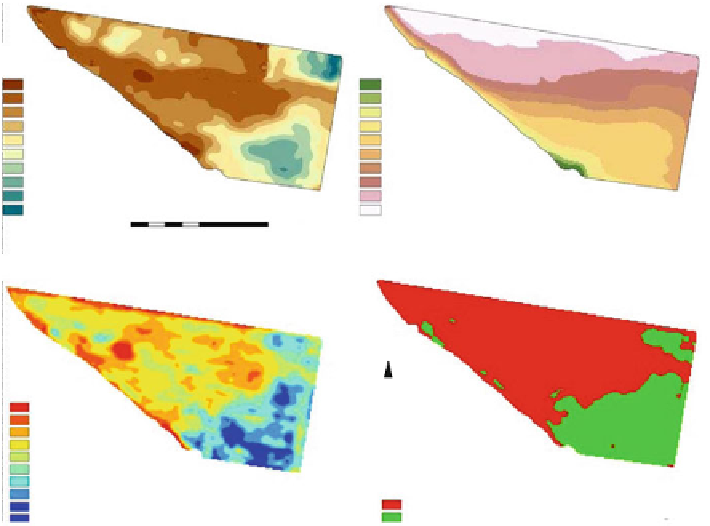Agriculture Reference
In-Depth Information
electr.
conductiv.
6 - 12
13 - 19
20 - 25
26 - 32
33 - 38
39 - 44
45 - 51
52 - 57
58 - 64
65 - 70
elevation
in m
0.0 - 0.4
0.5 - 0.8
0.9 - 1.2
1.3 - 1.6
1.7 - 2.0
2.1 - 2.4
2.5 - 2.8
2.9 - 3.2
3.3 - 3.6
3.7 - 4.0
in mS / m
in all cases add 340 m in elev.
0
250
500 m
N
wheat yield
in t
O
1.5 - 1.9
2.3 - 2.7
3.1 - 3.5
3.9 - 4.4
4.8 - 5.2
management zone
2
Fig. 13.5
Electrical conductivities, elevations, crop yields and management zones for a 40 ha fi eld
in Australia (From Whelan and Taylor
2010
, altered)
several successive farming operations such as soil cultivating, sowing and fertilizing.
This more general application of management zones makes the control with high
spatial resolutions diffi cult. The prerequisites for a control with small cell sizes are
better, if this is oriented just at one farming operation,
e.g.
fertilizing nitrogen.
It deserves attention that site-specifi c control of farming operations can be real-
ized either by a predictive- or by a reactive approach. The basis of a
predictive
approach
are temporally stable soil properties such as texture, organic matter con-
tent, cation-exchange-capacity, elevation and slope orientation. These properties
lend themselves for map-overlay and management zones.
In contrast to this, a
reactive approach
relies in addition on temporally varying
phenomena, such as the water situation in soils or crops and canopy properties that
can be detected via refl ectance or otherwise. Hence, a reactive approach is based on
the “reaction” to weather and crop development. Since it depends largely on tran-
sient properties, mapping the sensed results can be omitted. Instead, site-specifi c
control in an on-the-go manner and in real-time is an important objective. Whenever
sensible, sensor- and data fusion should be included.
Within this break-down into a predictive- and a reactive approach,
yield sensing
has an ambiguous position. It is part of a predictive approach when past site-specifi c
yields are included in the generating of management zones (Fig.
13.5
). But if yields
are used to detect the removal of nutrients and hence to control fertilizing rates





